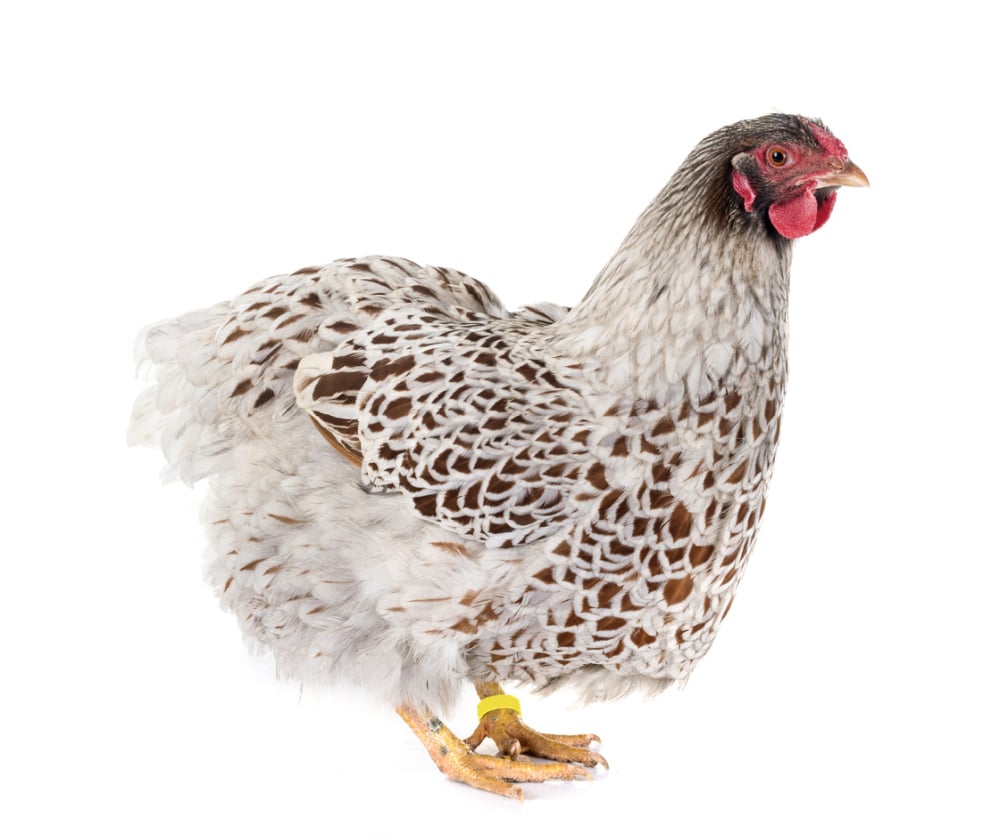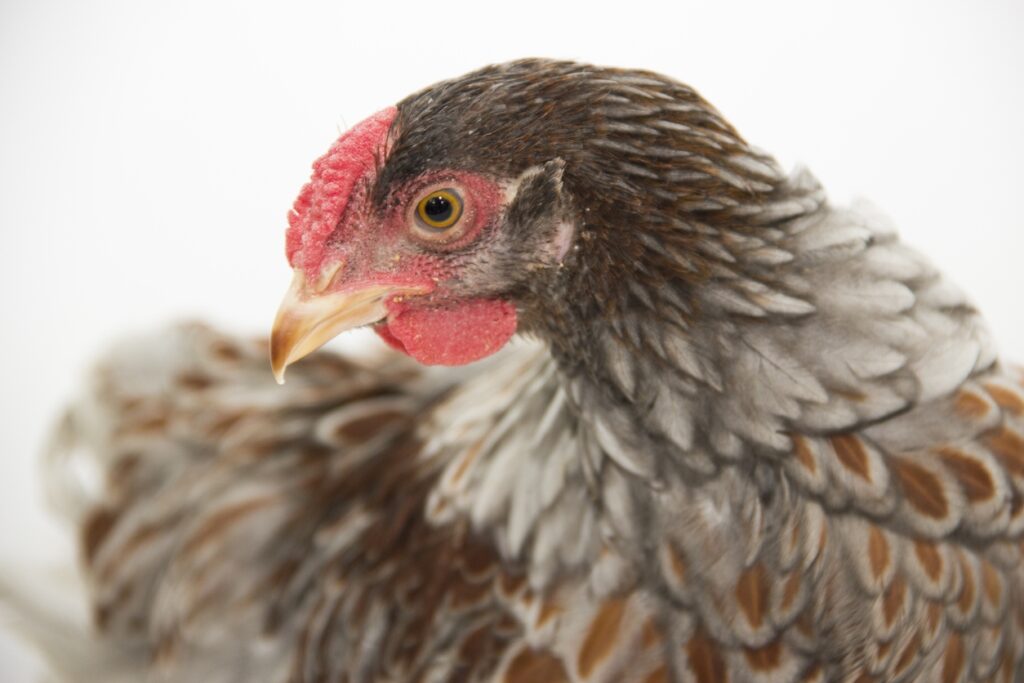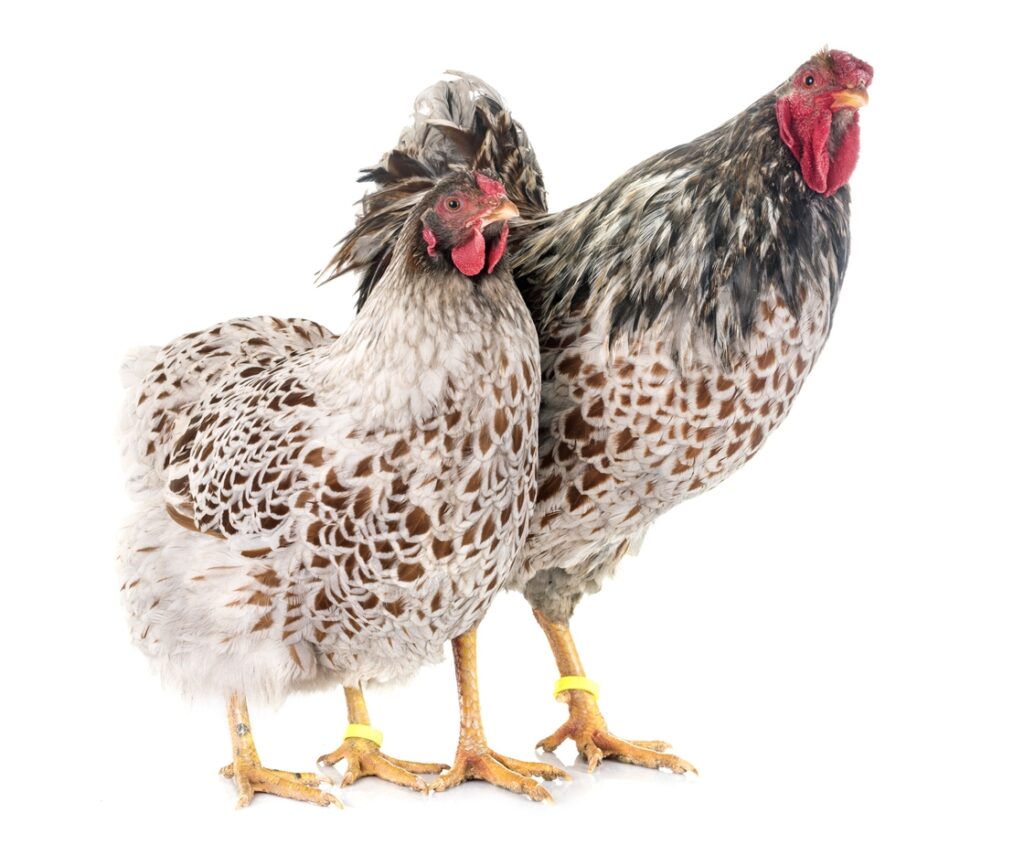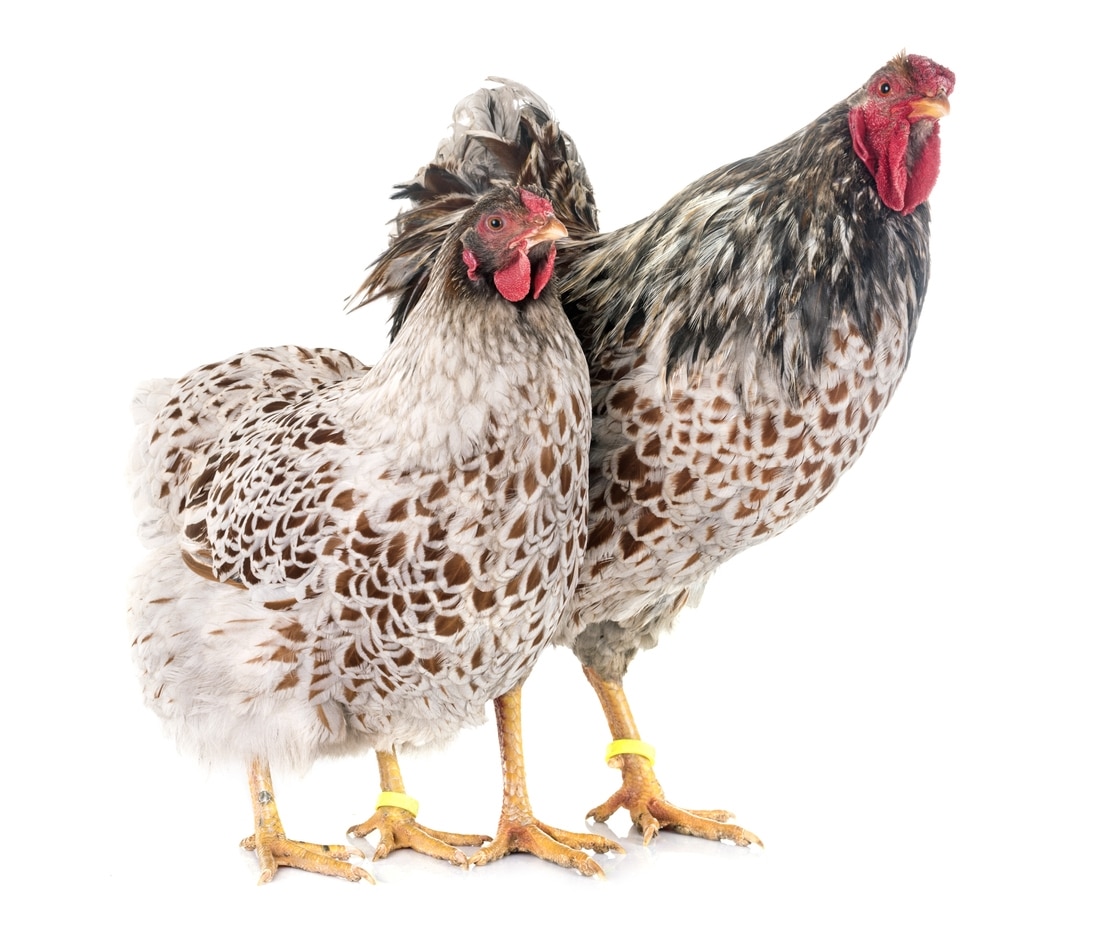Wyandotte chickens are a popular breed, but the Blue Laced Red Wyandotte is likely the most beautiful variant.
Many choose these chickens for their gorgeous feathers, but there’s a lot more to them than just looks. They can make great egg layers and meat providers, so let’s find out what their characteristics are and how to care for these birds.
[toc]
Blue Laced Red Wyandotte Overview
Before we observe the details of the Blue Laced Red Wyandotte, here’s an overview of the breed’s traits.
| Lifespan | 5 to 12 years |
| Weight | 6 to 9 pounds |
| Appearance | Red feathers with blue lacing |
| Egg Production | 4 eggs per week, 200 annually |
| Egg Color | Brown |
| Good for Beginners? | Yes |
| Minimum Coop Size | 8 to 10 square feet per bird |
| Price | $30 to $40 per chick |
Blue Laced Red Wyandotte History

Wyandotte chickens were first bred in the United States in the 1870s. H.M. Doubleday, Fred Houdlette, John Ray, and L. Whittaker worked together to create the first chicken of this breed, which had silver laced feathers.
The birds are native to New York, and the name ‘Wyandotte’ is the recognized named of a Native American tribe. However, it’s unclear if there’s any correlation between the two since a lot of the breed’s history is unknown.
It’s suspected that the first Wyandottes came from a silver spangled Hamburg chicken and a dark Brahma chicken. Over time, the breed became recognized in other countries too, which is when other color varieties, such as the Blue Laced Red Wyandotte, were created.
Even though Wyandottes first appeared in America, it’s unclear where first Blue Laced Red Wyandotte was bred. Some believe it came from Germany while others think it was shipped from the U.S. to Europe.
These chickens were bred to be good suppliers of both eggs and meat. They’re still popular for those purposes today.
Blue Laced Red Wyandotte Appearance
Blue Laced Red Wyandotte chickens have a distinct appearance as adults, but they look a bit different throughout every life stage. Here’s what to expect as they grow.
What Color Eggs Do Blue Laced Red Wyandottes Lay?
Blue Laced Red Wyandotte chickens lay large brown eggs. Sometimes the eggs are also speckled with white or dark brown pigments.
Blue Laced Red Wyandotte Chick Appearance
Blue Laced Red Wyandotte chicks are usually yellow and fuzzy like most chicks, but the tips of their feathers are a darker brown color.
However, it’s difficult to tell the difference between males and females when they’re chicks. Once they reach eight weeks old, you might notice some differences. Particularly, the males have sturdier bodies at that point. Behavior-wise, male chicks are also more bold, assertive, and curious while female chicks tend to be quieter and more timid.
Blue Laced Red Wyandotte Adult Appearance
Wyandottes are large, round chickens with red wattles and a small red comb. Their legs are a light yellow color while they’re beaks are slightly darker. Their legs look short, but they can easily support the chicken’s weight.
This variant of Wyandotte has dense feathers with unique colors. The feathers on their back are a red/chestnut color. The feathers on their belly are a similar color, but they have a thin line of blue/gray on them. Their under layer of feathers is also a blue/gray color.
Blue Laced Red Wyandottes are only one variant of the breed. Other Wyandotte colors include silver laced, gold laced, black, partridge, buff, and blue.
Size and Weight
All Wyandottes are large chickens, but their fluffy feathers make them look even bigger. Hens are usually about 6.5 pounds while roosters are 8.5 pounds.
Breed Standard
Blue Laced Red Wyandottes aren’t recognized by the American Poultry Association (APA), so they don’t have an official breed standard. Yet, you can expect them to look like the size and shape of any other Wyandotte, but with a unique color pattern.
Blue Laced Red Wyandotte Temperament
Wyandottes are considered friendly, docile chickens. They rarely get upset, which makes them great around people, even children. They don’t mind being held if they get used to it at a young age, but they’re not usually considered “lap chickens.” They don’t mind being around people, but they won’t make good family pets.
These birds are also highly adaptable, so whether you keep them confined or allow them to free-range, they’ll be content, as long as they have their basic needs. These personality traits make these birds perfect for new chicken keepers.
Broodiness

These hens aren’t known to go broody, but they can make great mothers. They will accept any egg placed under them as their own, and they’ll sit on eggs and keep them warm until they hatch. That way, you don’t have to rely on an incubator to help the eggs hatch if you don’t want to.
While this behavior might work well for keepers looking to breed the chickens, Blue Laced Red Wyandottes are prone to fertility problems due to their fluffy feathers. So, they can be difficult to breed.
Noise Levels
For the most part, Wyandottes are quiet and peaceful. Yet, some have still been known to be talkative, so it depends on the individual chicken. Since it’s unclear how chatty these birds will be, it’s a good idea to keep them far away from neighbors to make sure your hens don’t bother anyone.
Roosters are much more chatty than hens, and they might make crowing noises in the morning. So, if you’re not planning to breed your chickens, you might want to avoid getting roosters.
Do Blue Laced Red Wyandottes Get Along with Other Animals?
Blue Laced Red Wyandottes prefer to be kept with chickens of the same breed. While they’re unlikely to pick fights with other animals, they won’t hesitate to fight back if another critter picks on them. Since Wyandottes are usually docile, it’s likely that other birds will try to bully them.
Blue Laced Red Wyandotte Care Requirements
It’s no surprise that Blue Laced Red Wyandottes are beautiful, but there’s more to think about that just their appearance. So, here are some tips for how to care for this breed.
Diet
Like all chickens, Blue Laced Red Wyandottes should have access to clean water and food at all times. When they’re chicks, you should start off with a high-protein crumble with about 20% protein. Crumbles are easier for chicks to swallow than pellets.
Then, as they age, you can slowly decrease the amount of protein. By the time they’re 16 weeks old, you can give them a 16% protein layered feed. You’ll also want to give your hens oysters for additional calcium. The oysters should be served separately from the food.
Wyandottes are also good foragers, so if you give them time to roam, they will also find some nutrients on their own. They will eat bugs and other pests for you, which is good for their health. Even then, most 6-pound chickens will eat about 3 pounds of feed per week.
Habitat Setup

When setting up a coop, Wyandottes need a minimum of eight to ten square feet per bird. If they’re kept with other chicken breeds, more space is necessary to prevent them from fighting.
Since they’re larger chickens, they also need plenty of perch space. Each chicken should get 10 to 12 inches of roosting space. However, in the winter months, the chickens will likely sit closer to each other to keep warm. They’ll take full advantage of the extra space in the summer.
Also, when supplying nesting boxes, make sure they’re about 12 inches by 12 inches. That’s enough space to keep the hens comfortable without allowing a second bird to squeeze in. Too many chickens in one nesting box could put the eggs at risk of breaking.
Wyandotte chickens tolerate being confined well, so you don’t have to offer them free-range time if you don’t want to. If you keep them in an enclosure at all times, you’ll need to make sure it has more than enough room to explore and plenty of items, such as chicken toys, to keep them occupied.
These birds can’t fly very well, so a 3-4 foot fence is enough to keep them confined. The only issue with providing them free-range time is that their lack of flying makes them more at risk to wild animals hunting them.
Temperature
Blue Laced Red Wyandotte chickens were bred in cold climates, so they tolerate winters well. Snow and ice don’t bother them, but they should still have suitable shelter during all seasons. Their dense feathers help keep them warm.
However, these birds might not handle sweltering hot days well. Chickens use their combs to regulate body temperatures, but since their combs are so small, it’s hard for them to stay cool in the summer. Make sure they always have access to shade and water to prevent any heat-related issues.
If you live somewhere that gets really hot in the summer, you might want to add a fan to your chicken coop. The coop should be well-ventilated to allow proper airflow when the chickens are inside.
Health Concerns
Overall, Blue Laced Red Wyandottes are healthy birds. As mentioned earlier, they have low fertility and are prone to heat-related health concerns. Other than those issues, most of their health problems are similar to most chicken breeds.
Most chickens are at risk of carrying parasites, such as mites, lice, and worms. Chickens can be given preventatives for these on a regular basis. Cleaning their bedding and bowls regularly can also help prevent the spread of parasites. Providing dust baths is another way to help prevent parasites from living in the chickens’ feathers.
Having a lot of feathers near their rear end isn’t just a problem for breeding, but it can also cause feces and debris to build up in their feathers. So, even if you’re not planning to use your chickens for breeding, it’s still a good idea to occasionally trim the feathers on their bottom to prevent a blockage.
Blue Laced Red Wyandottes are in popular demand, so many of the people who breed them don’t do it responsibly. They might breed “inferior” birds, causing the chicks to be prone to more health issues. If you only get birds from reputable breeders, you’ll be less likely to buy sick birds.
How to Breed Blue Laced Red Wyandottes

Wyandottes might not be the easiest birds to breed, but it’s not impossible to do it. If you want to add some birds to your coop, then you can add some roosters to the hen enclosure to get more chicks.
The roosters and hens will breed on their own once kept in the same enclosure. However, the fluffy feathers make it difficult for them to produce fertile eggs. To help the chickens be more likely to produce chicks, you can trim the feathers around their bottoms to make mating easier.
After a hen and rooster mate, it may take a little while for fertile eggs to be produced. If you don’t want any chicks in your coop, then keep roosters separate from hens or don’t buy any roosters to being with.
Egg Production
Blue Laced Red Wyandottes lay about 4 eggs per week, which ends up being close to 200 per year. While many hens stop laying eggs in the winter, Wyandottes lay eggs year-round since they’re used to the cold weather.
Wyandottes usually start laying eggs at 16 to 20 weeks old, which is about average. They lay large brown eggs.
Are Blue Laced Red Wyandottes the Right Chickens for You?
It’s no surprise that Blue Laced Red Wyandottes are beautiful, but how do you know if they’re right for you? Whether you’re looking for meat or eggs, these large chickens can be used for both. They’re the perfect dual-purpose hens.
However, Wyandottes are large chickens, so they need more space than some breeds. Make sure you have enough room for them before committing to their care. If you think you have what it takes to keep these beautiful birds, then they’ll be a great addition to your yard or farm.
